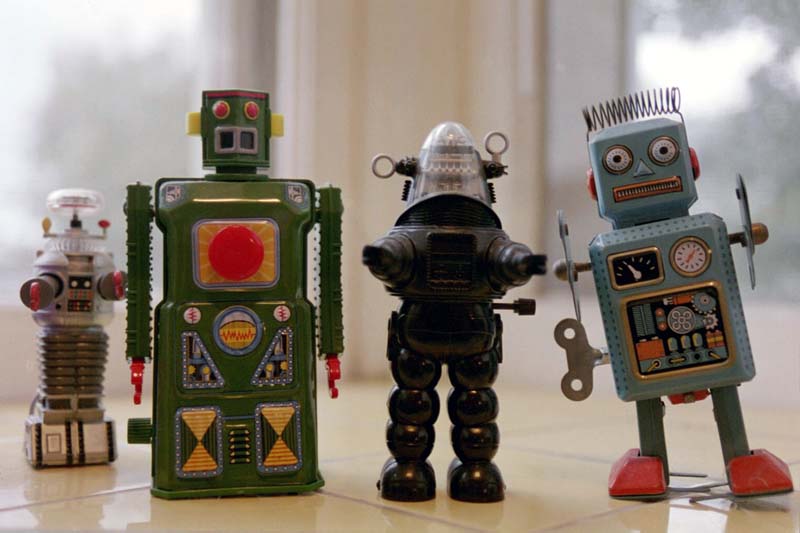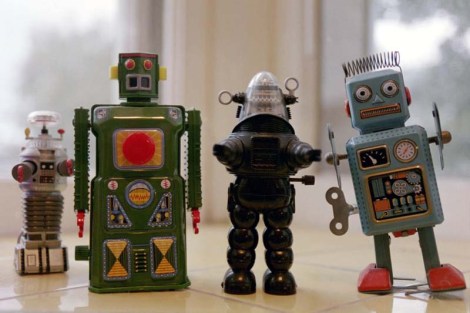I’m not going to respond to all the points in this GM Watch deconstruction of my post about Arpad Pusztai, the scientist whose experiments testing the safety of genetically engineered potatoes ignited a controversy. But there are three interesting points that I think that critique got right, to one degree or another.
Before I examine those, I think it’s worth commenting on the way this process of rebuttal plays out, now that I’ve been run through the cycle a couple times myself. There’s something fascinating about how each statement in this conversation elicits an immediate and automatic response. At times I feel as if I’m standing between two giant argument machines: Each takes in every argument, runs it through an algorithm, and spits out the pre-formulated retort. One talking point reflexively provokes another, which then triggers a third. It’s like two computers engaged in an endless series of tic-tac-toe games — and it makes for a sterile, airless debate.
There is, however, one good reason for these automatic responses: The debate has been going on for so long that every point has been made over and over. So when a tired old assertion gets brought up again (by me, for instance), it only makes sense for someone who disagrees to trot out the same old information to debunk it.
That’s all for the good. But this mechanical approach becomes a problem when it extends beyond correcting old misconceptions into automatic rejection of new information. People stop listening to each other. Minds close, the better to concentrate on building the next set of talking points. Yet the ultimate power of the mind lies in its ability not to convince, but to change.
The philosopher Daniel H. Cohen says there are three ways to think of an argument. Mostly, people think of arguments as battles to be won. But this metaphor doesn’t fit because, while you can win a battle by forcing your opponent into submission, in a war of words you can’t ever force your opponent to submit. Eventually, you’ll need his cooperation to stop shouting “is not!” and tell you you’ve won.
An argument can also be seen as a performance, where the point isn’t to convince your opponent, but to convince the people watching (a jury, for instance) that you’ve won. It’s clear that a lot of the GMO debate is purely performative, done for the benefit of onlookers whose minds aren’t made up.
But there’s also a third, truly useful way of thinking about argument: Argument as collaboration, where two parties, by challenging each other, build to a stronger conclusion than they could have ever reached alone. That’s such an underused way of thinking about argument that it doesn’t even fit comfortably within our definition of the word. But that’s the kind of argument I’m trying to conduct here to figure out where I stand on GM food.
I’m trying to learn, and the only way to learn (in argument-as-battle mode) is to lose. The winner gains nothing.
It was in that spirit that I read the GM Watch piece, and discovered three points where I thought I might be in error: First, in my assertion that Pusztai hadn’t used the correct controls in his experiment; second, in the claim that it should be easy for researchers in Australia to obtain seed for research; and third, in my failure to apply the same level of skepticism to studies that fail to find harm in GMOs and those that do suggest some hazard.
Here’s what I learned:
1. Did Pusztai use exactly the right controls?
The GM Watch piece points to this interview in which Pusztai says that the whole reason he worked with potatoes was to have the right controls:
And that was the reason why we did use GM potatoes, because they were developed by a Cambridge team together with our friend in Durham to transfer the transgene into potatoes to make them resistant to aphid attacks. Because we could get this material and the parent-line potatoes in sufficient quantities – they were grown side-by-side in the UK under controlled conditions – so we had the material to carry out these studies.
I didn’t know about this, and it’s certainly relevant information. Pusztai’s critics point out that the original review [PDF] of Pusztai’s work by the Royal Society had noted that there was very little information recorded in the lab notes about how the controls differed from the experimental diets, nor was such information included when the Lancet published Pusztai’s study.
I have not been able to interview Pusztai himself to help understand that discrepancy. In the end, I think we need to give him the benefit of the doubt. I’m inclined to agree that I got this wrong. That leaves us with a single study suggesting a mild whiff of risk — and reinforces the conclusion I originally drew. The lesson here is that we should create as much room as possible for GM-critical scientists to put their ideas to rigorous and open test.
2. Is it impossible for many scientists to study patented GM crops?
I’d noted that the researchers of a recent study comparing GM and conventional corn said they couldn’t get genetic matches to GM feed because of intellectual property restrictions. But I assumed that they could have partnered with any researcher at a university in the United States that had permission to study patented seeds. GM Watch called this “touchingly naive,” which is actually quite a sweet sentiment (honestly), under the circumstances.
It’s true: I didn’t really know how hard it would be to find a collaborator with access to patented seeds. I emailed Judy Carman, director of the Institute of Health and Environmental Research in Australia and the lead researcher in the corn study. Carman responded that patents and restrictive contracts tie researchers’ hands and that GM food producers only cooperate with universities they approve of.
I also emailed Kevin Folta, a plant scientist at the University of Florida, who said just the reverse. He could have grown the corn because his university has free rein to experiment with patented seeds.
“She could have asked me, any of my colleagues that work in corn here at my university, or any of the thousands of other independent researchers in the USA,” Folta responded. “Who did she contact that turned her away? … Any seeds used could easily be obtained under an Academic Research License and results distributed freely. No problem.”
But, I pressed, wouldn’t it be harder to get the non-GM parent plants to use as a control? No, Folta replied, those seeds are also available under the agreements companies have made with universities: “no questions asked from most companies.”
Before 2009, some scientists really did have some trouble doing their work, due to patent restrictions. But the same scientists who protested the limitations now say the problem is largely fixed.
Carman brought up another point:. There simply isn’t a non-GM parent for the type of corn she was testing, because that corn was made by crossing multiple GM varieties. There are ways around this: you could use the GM parents as controls in addition to a non-GM control. Or you could choose to study a simpler strain. But Carman is right: It would be impossible her to get a non-GM parent — not because of patent restrictions, but because it doesn’t exist.
On this point I was wrong to make an assumption, but after checking it out, I’m still standing by my assumption that, since 2009 at least, researchers have had much better access to GM seeds.
3. Do I fail to apply my skepticism fairly?
This one is interesting. After accusing Carman and Pusztai of failing to use the correct controls, I cited this review paper, claiming: “when long-term feeding trials are done so as to compare apples to apples, they’ve reinforced the conclusion that genetically modified foods are safe.”
Ah the irony. Only 7 of the 24 studies in that paper use the correct controls. It’s a bit hypocritical for people (like me!) to knock studies that find problems with GMOs for failing to use non-GM parent plants as controls, then trumpet other studies that did exactly the same thing. (Doug Gurian-Sherman has also made the case that this study isn’t the last word on safety.)
I’m clearly guilty as charged on this count, and I wanted to know why so many scientists had done the same thing. I asked Folta about this as well. “Why” he wrote, “do you need a non-GM control to show harmlessness, when the GM product and non-isogenic lines show the same thing?” In other words, if you find a toxin, you want a control to be sure that that toxin is coming from the genetic engineering and not something else. But, if you don’t find anything to worry about, why do you need a control?
It doesn’t make sense, he said, to demand the same level of evidence from all scientific findings:
The claim that the approach used in 70% of American food is dangerous has no foundation. Those that support the hypothesis that GM crops are dangerous need to have the cleanest experiments, perfect controls, massive numbers, good replicates and appropriate statistics. They are trying to overturn a paradigm, a scientific consensus. This is where GM Watch goes off the deep end. They think that the pro- and anti-GM science has a similar threshold. It does not.
For example: To test the hypothesis that gravity does not exist on earth I need some elaborate mechanisms, many replicates, tons of math and new models of thinking that change our understanding of basic fundamentals of natural science. To test the hypothesis that gravity exists, I have to push a pencil off of my desk. Two very different evidence thresholds.
The rub is that what seems as intuitive as gravity for most plant scientists is counterintuitive for most Americans. We start from the assumption that genetic engineering is still a novelty and carries risks.
There’s a larger point here, though, I think: No matter how hypothetical the hazard, it appears unacceptable if people aren’t getting anything in return. The argument machines mostly operate around the question of health, but I’m ready to move on. I hope to leave this debate over risk long enough to look at the big picture and ask, who benefits from genetic engineering?
More in this series:
- The genetically modified food debate: Where do we begin?
- The GM safety dance: What’s rule and what’s real
- Genetic engineering vs. natural breeding: What’s the difference?
- Is nature a cradle or a battlefield?
- Genetically engineered food: Allergic to regulations?
- Genetically modified seed research: What’s locked and what isn’t
- Genetically modified literature (in which I read books so you don’t have to)
- Is extremism in defense of GM food a vice?
- Elephant in the room: Why getting the GMO story straight is so hard




